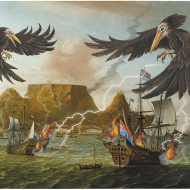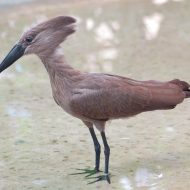Impundulu : The Lightning Bird
Listen
At a glance
| Description | |
|---|---|
| Origin | Zulu Mythology |
| Classification | Animals |
| Family Members | N/A |
| Region | South Africa |
| Associated With | Lightning, Blood sucking |
Impundulu
Introduction
The Impundulu, translated as the “lightning bird” in Zulu, emerges as a formidable and fear-inducing entity within Zulu and other Nguni cultures, including Xhosa and Pondo. This avian monstrosity is frequently depicted as a potent symbol of malevolence, death, and the arcane arts, capable of instilling dread with a mere mention of its name. The Impundulu, a mythical creature entrenched in the folklore of various African tribes, particularly the Zulu people of South Africa, embodies the essence of a creature that holds sway over the natural elements.
In Zulu, the term “impundulu” directly translates to “lightning bird,” encapsulating the essence of a winged being endowed with the ability to summon thunder and lightning through the sheer force of its wings and razor-sharp talons. This mythical creature not only commands the elements but is also intricately linked with themes of witchcraft, vampirism, and seduction, often serving as a familiar or devoted servant to a witch or witch doctor. In this exploration, we delve into the physical characteristics, familial connections, alternate names, powers and abilities, and the contemporary impact of the Impundulu.
Physical Traits
In accordance with Zulu tradition, the Impundulu is believed to originate from the tumultuous heart of thunderstorms and lightning, emerging as a manifestation of the most intense and formidable forces of nature. Various legends offer divergent narratives about its genesis, with some portraying it as an ordinary bird undergoing a profound transformation when struck by lightning, while others contend that it materializes directly from the bolts of lightning themselves.
The Impundulu, characterized by its black and white plumage reminiscent of a crow or eagle, possesses a formidable arsenal of physical attributes. It boasts a sizable beak and razor-sharp claws capable of rending flesh and bone, accompanied by iridescent feathers that refract light in a dazzling array of colors. Accounts of its size vary, but some descriptions paint the Impundulu as an impressive creature measuring five feet in length with a wingspan stretching to twelve feet.
Depictions of the Impundulu consistently showcase it as a substantial avian entity, akin in size to a human. Its plumage, marked by alternating black and white feathers, creates a visually striking contrast. The creature is renowned for its sharp talons and a formidable beak, endowed with the capacity to inflict grievous injuries. Some narratives even allude to a long tail adorned with feathers capable of sparking electricity, further enhancing the creature’s supernatural aura.
Legend has it that the Impundulu possesses a unique ability to shape-shift at will, assuming different forms as the situation demands. This extraordinary skill introduces an element of unpredictability, augmenting the creature’s already formidable and mysterious nature. For those steeped in Zulu cultural heritage, the enigma surrounding the Impundulu is heightened by its shape-shifting prowess, leaving an indelible mark on the mythological landscape of the Zulu people.
Family
The Impundulu is a social creature, commonly found residing in groups alongside other impundulus or birds of a similar nature. These collective gatherings are referred to as “flocks” or “herds” of impundulus, and they operate under the guidance and protection of an elder impundulu serving as the group’s leader. Distinguished by its larger size and extensive experience, the elder impundulu holds authority over the others, who unquestioningly follow its commands. The group dynamic ensures a structured order within the impundulu community.
Contrary to the image of a solitary being, the Impundulu is often viewed as a familiar associated with witches, passed down through familial generations. In certain narratives, the creature is believed to be the progeny of a union between a witch and a lightning bolt, endowing these offspring with exceptional power and perilous potential. This association with witchcraft complicates the relationship between the Impundulu and the people of Zulu culture. While the Lightning Bird instills fear and awe as a symbol, it concurrently serves as a source of power for those who can wield its allegiance. This duality adds a layer of complexity to the creature’s role within Zulu mythology.
Other names
Impundulu, the mythical creature with a formidable presence in various African cultures, is bestowed with a multitude of names across the continent. In Xhosa, it is referred to as Thekwane, meaning “lightning bird.” The Zulu language echoes this symbolism with the name Izulu, while the Zululand language contributes Inyoni yezulu, all translating to the evocative “lightning bird.” Furthermore, the moniker Hamerkop is assigned to a bird specializing in fish consumption, bearing a resemblance to the famed Impundulu. In a cross-cultural parallel, Nuckelavee emerges from Irish folklore as a mythical creature sharing distinct similarities with the African Lightning Bird.
Beyond its primary designations, the Impundulu assumes various identities contingent upon specific cultural and regional contexts. Among these alternative names, Inyoni yezulu signifies the “bird of the sky,” capturing the creature’s ethereal connection. Ishologu, denoting a cursed bird, adds an intriguing dimension to the creature’s mystique. Inyoka yezulu translates to the “snake of the sky,” introducing serpentine imagery into the intricate narrative of the Impundulu. Lastly, Impundulukazi designates the female counterpart of the Impundulu, underscoring the gender diversity within the folklore surrounding this enigmatic creature.
Powers and Abilities
Impundulu, entrenched in African folklore, is renowned for its array of powers and abilities, rendering it one of the most feared creatures in the cultural narratives of the continent. Among its formidable capabilities is the power to summon thunder and lightning, manipulating the weather with its wings. This mythical bird extends its influence by generating bolts of electricity that can strike down enemies or kindle fires, adding to its aura of elemental control.
In the realm of mobility, Impundulu surpasses the natural world, soaring through the skies at speeds of up to 300 miles per hour. Its agility is further showcased as it maneuvers through tight spaces with ease, evading obstacles effortlessly. This avian entity’s exceptional aerial prowess contributes to the mystique surrounding it. Impundulu’s enigmatic nature deepens as it reveals the power of transformation into human form. This ability allows the creature to seamlessly integrate into human society or engage in seduction. Frequently adopting the appearance of young and attractive men, Impundulu perfects the mimicry of human speech and behavior, emphasizing its adaptability.
Another chilling facet of Impundulu’s repertoire is its insatiable appetite for blood. Feeding on humans or animals whenever the opportunity arises, the creature leaves no trace behind after draining its victims entirely. This predatory behavior adds a macabre dimension to its fearful reputation. An enduring theme within the lore of Impundulu is its perceived immortality. Unlike its mortal owners who eventually pass away, the creature persists through the ages. This longevity allows it to pass down accumulated knowledge and skills to successive generations, contributing to its role as a timeless and enduring force within the mythological landscape.
Beyond these powers, Impundulu is associated with a myriad of abilities. It is believed to have control over weather phenomena, including storms, lightning, and thunder. Its wings, according to legend, create the thunderous sounds, while the mere touch of Impundulu is thought to bring forth lightning striking the ground.
Impundulu’s connection with misfortune and death is woven into its narrative, with the capacity to cause illness or even death through its gaze, touch, or breath. Shapeshifting tales are also prevalent, suggesting that the creature can assume various forms, including humans or other animals. In darker narratives, Impundulu’s haunting ability to steal the souls of its victims adds an even more ominous layer to its myth. This act is believed to condemn those affected to eternal torment. As the embodiment of enduring power, living for centuries or even millennia, Impundulu’s multifaceted nature solidifies its status as a formidable and timeless figure in African mythology.
Modern Day Influence
The Impundulu remains a potent symbol in contemporary Zulu culture, permeating various aspects of artistic expression. Its evocative image finds resonance in storytelling, visual arts, and musical compositions, serving not only as a cultural motif but also as a cautionary emblem. Through narratives and representations, the Lightning Bird continues to warn people of the perils associated with witchcraft and malevolence, preserving its role as a powerful allegory in Zulu society.
In recent years, the Impundulu has transcended cultural boundaries and gained popularity in Western contexts. Its presence is notable in literature, film, and even video games, contributing to its recognition among a broader audience. This increased exposure serves as a conduit for introducing the captivating creature to new cultural landscapes.
Renowned African authors, including Njabulo Ndebele (The Lightning Bird), John Agard (The Storm), Chinua Achebe (No Longer at Ease), Ngugi wa Thiong’o (Petals of Blood), and Chimamanda Ngozi Adichie (Americanah), have featured the Impundulu in their literary works. These narratives contribute to the creature’s enduring presence in the literary realm.
African filmmakers, such as John Akomfrah (The Devil’s Backbone), Wanuri Kahiu (Queen Sono), and Tsitsi Dangarembga (An Elegy for Easterly), have brought the Impundulu to life on the cinematic screen. These cinematic interpretations provide a visual dimension to the mythical creature’s continued relevance.
The influence of the Impundulu extends to the realm of music, inspiring compositions by celebrated African musicians. Songs such as Miriam Makeba’s “Pata Pata,” Hugh Masekela’s “Zimbo,” and Fela Kuti’s “Zombie” draw inspiration from the rich mythos of the Lightning Bird, contributing to a sonic tapestry that echoes the cultural significance of this mythical entity.
In essence, the Impundulu’s enduring impact on literature, film, and music reflects its ability to transcend temporal and geographical boundaries, solidifying its status as a timeless symbol that resonates across cultures.
Related Images
Frequently Asked Questions
What is lorem Ipsum?
I am text block. Click edit button to change this text. Lorem ipsum dolor sit amet, consectetur adipiscing elit. Ut elit tellus, luctus nec ullamcorper mattis, pulvinar dapibus leo.
What is lorem Ipsum?
I am text block. Click edit button to change this text. Lorem ipsum dolor sit amet, consectetur adipiscing elit. Ut elit tellus, luctus nec ullamcorper mattis, pulvinar dapibus leo.
What is lorem Ipsum?
I am text block. Click edit button to change this text. Lorem ipsum dolor sit amet, consectetur adipiscing elit. Ut elit tellus, luctus nec ullamcorper mattis, pulvinar dapibus leo.
What is lorem Ipsum?
I am text block. Click edit button to change this text. Lorem ipsum dolor sit amet, consectetur adipiscing elit. Ut elit tellus, luctus nec ullamcorper mattis, pulvinar dapibus leo.
What is lorem Ipsum?
I am text block. Click edit button to change this text. Lorem ipsum dolor sit amet, consectetur adipiscing elit. Ut elit tellus, luctus nec ullamcorper mattis, pulvinar dapibus leo.









